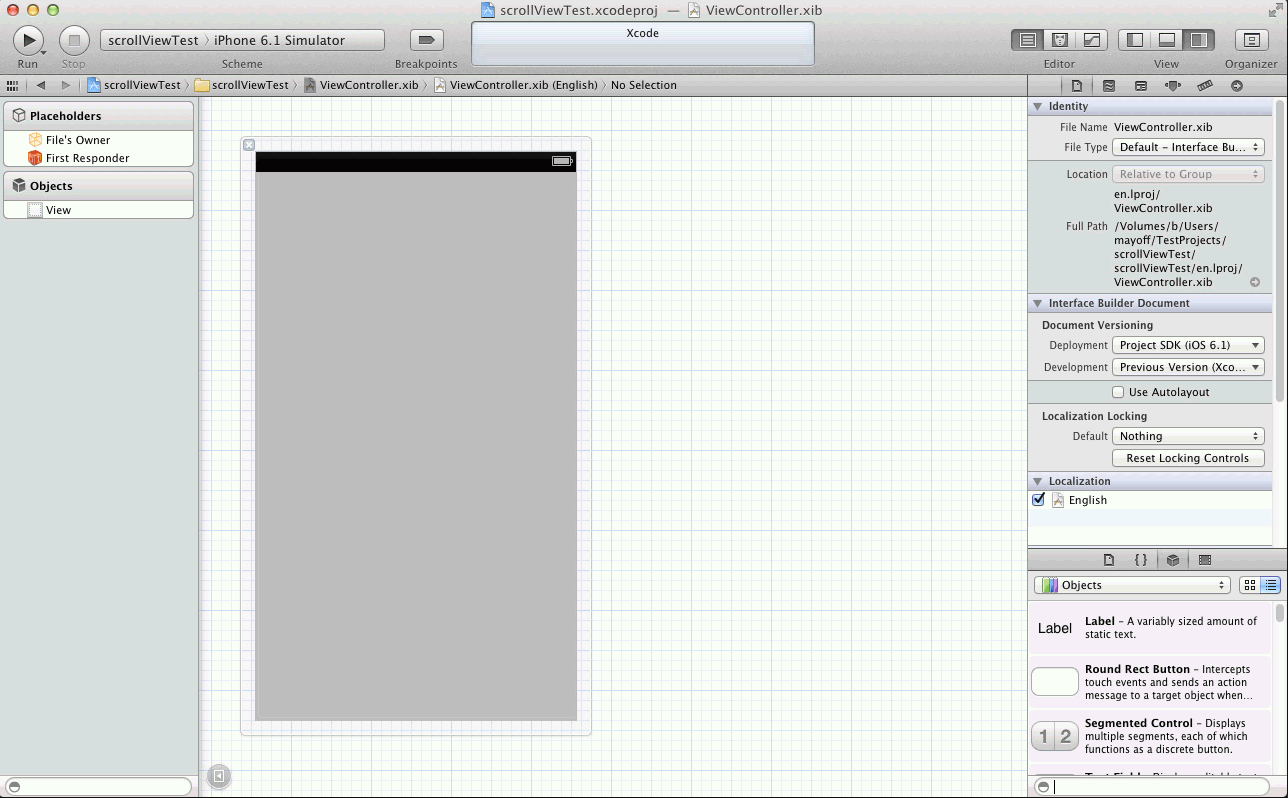如何轻松地在笔尖中设计UIScrollView的内容
我有一个滚动视图,必须显示大于可用显示区域的视图。 我想轻松设计用户界面,而不必在每次必须进行一些更改时上下移动嵌入式视图。 问题是可见区域外的所有内容在IB中都是不可见的。
是否有任何开关或技巧可以在IB中显示所有内容?
1 个答案:
答案 0 :(得分:27)
更新
我发布了another solution here我认为更简单,更好,并且可以在故事板中使用。
ORIGINAL
使用适当的超视图,位置和大小在笔尖中创建滚动视图。
接下来,通过将UIView拖出调色板并将其放入任何现有视图之外的工作区域,创建一个完全独立的顶级 UIView实例。在“属性”检查器中,将“大小”弹出窗口设置为“无”,并确保“状态栏”,“顶栏”和“底栏”都设置为“无”。这是一个例子:
这个新的顶级视图将是您的内容视图。为视图控制器提供两个出口:scrollView和contentView:
@interface MyViewController
@property (nonatomic, weak) IBOutlet UIScrollView *scrollView;
@property (nonatomic, strong) IBOutlet UIView *contentView;
@end
在笔尖中,将scrollView插座连接到滚动视图,然后将contentView插座连接到内容视图。
在内容视图中构建内容视图层次结构。根据需要设置其大小 - 它可以大于320x480(只要您将其所有条形设置为无)。
在视图控制器的viewDidLoad中,添加contentView作为scrollView的子视图,并将scrollView.contentSize设置为contentView的大小:
@implementation MyViewController
@synthesize scrollView = _scrollView;
@synthesize contentView = _contentView;
- (void)viewDidLoad {
[super viewDidLoad];
[self configureScrollView];
}
- (void)configureScrollView {
CGSize size = self.contentView.bounds.size;
self.contentView.frame = CGRectMake(0, 0, size.width, size.height);
[self.scrollView addSubview:self.contentView];
self.scrollView.contentSize = size;
// If you don't use self.contentView anywhere else, clear it here.
self.contentView = nil;
// If you use it elsewhere, clear it in `dealloc` and `viewDidUnload`.
}
相关问题
最新问题
- 我写了这段代码,但我无法理解我的错误
- 我无法从一个代码实例的列表中删除 None 值,但我可以在另一个实例中。为什么它适用于一个细分市场而不适用于另一个细分市场?
- 是否有可能使 loadstring 不可能等于打印?卢阿
- java中的random.expovariate()
- Appscript 通过会议在 Google 日历中发送电子邮件和创建活动
- 为什么我的 Onclick 箭头功能在 React 中不起作用?
- 在此代码中是否有使用“this”的替代方法?
- 在 SQL Server 和 PostgreSQL 上查询,我如何从第一个表获得第二个表的可视化
- 每千个数字得到
- 更新了城市边界 KML 文件的来源?
